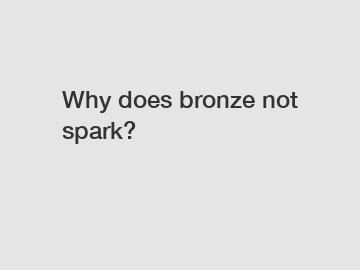Jan. 19, 2024
Tools
Why does bronze not spark?
Bronze, an alloy made primarily from copper and tin, has been used by humans for thousands of years due to its durability and versatility. However, one peculiar characteristic of bronze is its inability to spark. Unlike other metals, such as iron or steel, bronze does not create sparks when struck against a hard surface. This unique property has intrigued scientists and historians alike, leading to numerous theories and explanations. So, why does bronze not spark? Let's delve into the fascinating world of metallurgy and explore the factors that contribute to this intriguing phenomenon.
1. Composition Matters:

Bronze, as mentioned earlier, is primarily composed of copper and tin. The addition of tin to copper alters its properties, making it stronger and more resistant to corrosion. However, this alloy composition also affects its spark-producing ability. Copper, in its pure form, is known to generate sparks when struck with a hard object. But when tin is added to copper, it modifies the structure significantly, making it less prone to spark formation.
2. Oxidation and Corrosion:
Another crucial factor contributing to the lack of sparks in bronze is the formation of a protective layer of oxidation on its surface. When bronze comes into contact with air, it gradually forms a thin layer of copper oxide, or patina, which acts as a barrier against further oxidation. This layer acts as a shield, preventing the exposure of the underlying copper to ignition sources and inhibiting spark formation.
3. Conductivity and Thermal Properties:
Bronze, being an excellent conductor of heat and electricity, offers a vital clue as to why it does not spark. When an object strikes a metal surface, the impact generates friction, which in turn produces heat. In metals like iron or steel, this heat accumulates and can ignite flammable materials, leading to sparks. However, bronze's high thermal conductivity rapidly disperses the generated heat, preventing it from reaching a temperature sufficient for spark formation.
4. Mechanics of Friction:
To understand why bronze does not spark, it is essential to examine the mechanics of friction. When two objects rub against each other, the friction creates resistance, leading to the generation of heat. This heat causes the molecules in the surface of the objects to vibrate vigorously. In metals like iron, these vibrations can dislodge tiny particles or shards, called "glowing debris," which become sparks. However, due to the unique properties of bronze, such as its high malleability and low carbon content, it lacks the brittle structure required for shard dislodgement, thus contributing to its non-sparking nature.
In conclusion, the question of why bronze does not spark can be attributed to a combination of factors. The composition of bronze, the formation of a protective layer of oxidation, its high thermal conductivity, and the mechanics of friction all contribute to its fascinating non-sparking property. This makes bronze a valuable material for various applications, especially those where the risk of fire and ignition needs to be minimized. The distinct qualities of bronze continue to captivate scientists and historians, reminding us of the complexities and wonders of metallurgy.
If you are looking for more details, kindly visit Non-Sparking Hearing Needle, Copper and Brass Hammer, Brass Tools For Sale.
Previous: Where can I find the best deals on automatic panel benders for sale?
Next: Maximize Efficiency & Power with Boost Air Compressors: Your Ultimate Guide!
If you are interested in sending in a Guest Blogger Submission,welcome to write for us!
All Comments ( 0 )